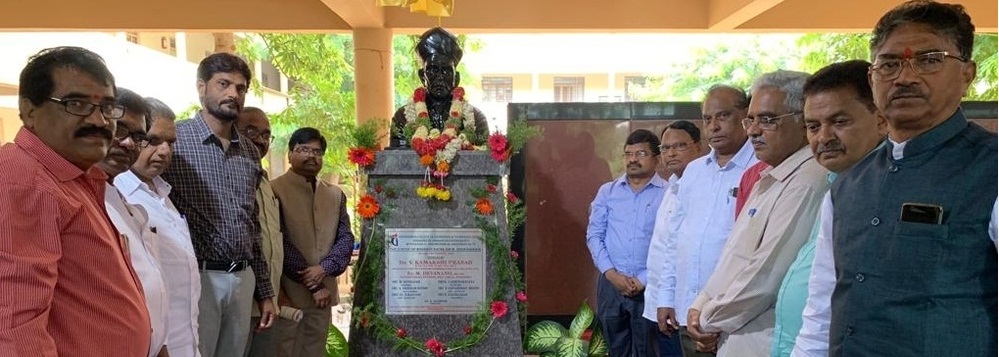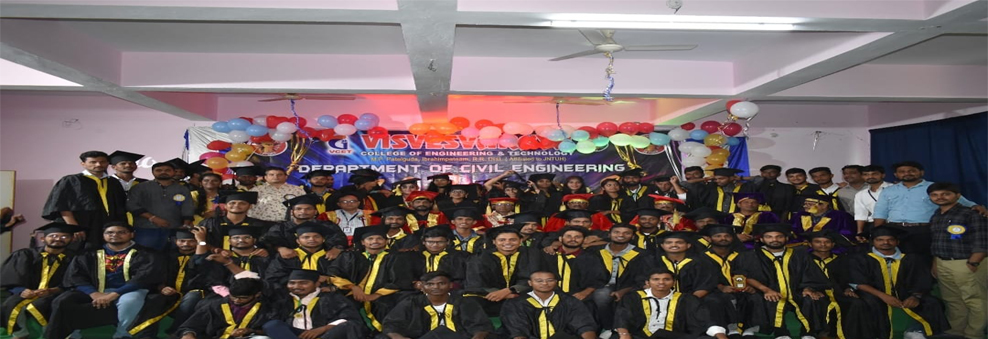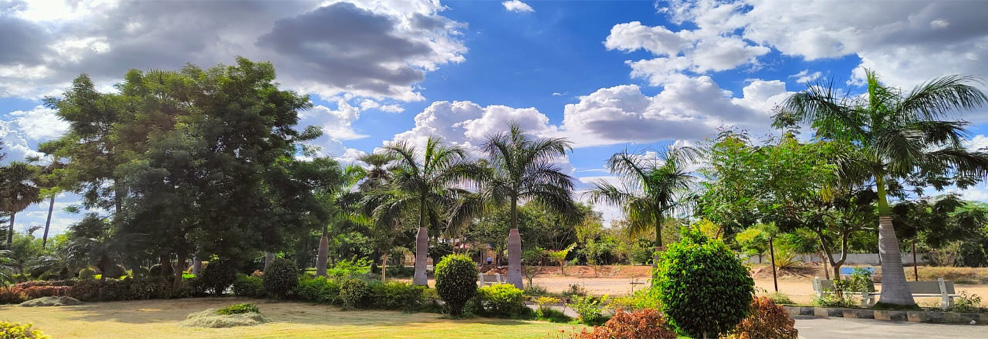Course Outcomes (CO)
Electrical & Electronics Engineering I & II Sem Course Outcomes for the Academic Year 2022-23
S.No |
Year/ Sem |
Course Name |
Course Outcomes |
1 |
II-I |
ELECTRICAL CIRCUITANALYSIS |
CO1: Apply network theorems for the analysis of electrical circuits |
CO2: Obtain the transient and steady-state response of electrical circuits. |
|||
CO3: Analyze circuits in the sinusoidal steady-state (single-phase and three-phase). |
|||
CO4: Analyze steady-state responses and transient response of DC and AC circuits using classical and Laplace transform methods. |
|||
CO5: Analyze two port circuit behavior. |
|||
2 |
II-I |
ELECTRICAL MACHINES - I |
CO1: Identify different parts of a DC machine & understand its operation |
CO2: ToCarry out different testing methods to predetermine the efficiency of DC |
|||
CO3: ToUnderstand different excitation and starting methods of DC machines. |
|||
CO4: Control the voltage and speed of a DC machines. |
|||
CO5: Analyze single phase and three phase transformers circuits. |
|||
3 |
II-I |
ELECTROMAGNETICFIELDS |
CO1:Understand the Basic laws of Electromagnetism. |
CO2:Obtain the Electric and Magnetic fields for simple configurations |
|||
CO3: Analyze  theTime varying electric and magnetic fields. |
|||
CO4: Understand the Maxwell's Equations in Different Forms and Different media |
|||
CO5: Understand the Propagation of EM waves |
|||
4 |
II-I |
ENGINEERING MECHANICS |
CO1: Determine resultant of forces acting on a body and analyze equilibrium of a body subjected to a system of forces. |
CO2: Solve problem of bodies subjected to friction |
|||
CO3: Find the location of centroid and calculate moment of inertia of a given section. |
|||
CO4: Understand the kinetics and kinematics of a body undergoing rectilinear, curvilinear, rotatory motion and rigid body motion |
|||
CO5: Solve problems using work energy equations for translation, fixed axis rotation and plane motion and solve problems of vibration |
|||
5 |
II-I |
ANALOGELECTRONICS |
CO1:Know the characteristics, utilization of various components.  |
CO2:Understand the biasing techniques |
|||
CO3:Design and analyze various rectifiers, small signal amplifier circuits. |
|||
CO4:Design sinusoidal and non-sinusoidal oscillators. |
|||
CO5: A thorough understanding, functioning of OP-AMP, design OP-AMP based circuits |
|||
6 |
II-I |
ELECTRICALMACHINES LAB - I |
 CO1: Observe Start and control the Different DC Machines. |
 CO2: Assess the performance of different machines using different testing methods. |
|||
 CO3: Identify different conditions required to be satisfied for self - excitation of |
|||
 CO4: Separate iron losses of DC machines into different components. |
|||
 CO5: Calculating different parameters in Machines. |
|||
7 |
II-I |
ANALOGELECTRONICS LAB |
CO1: Analyze the diode and transistor characteristics. |
CO2: Understand the principles of rectifier circuits using diodes and implement them usinghardware. |
|||
CO3: Design various amplifiers like CE, CC, common source FET amplifiers and implement them using hardware and also observe their frequency responses. |
|||
CO4: Understand the concepts of Oscillators and observe its frequency responses. |
|||
CO5:Understand the Inverting and non inverting amplifier and observe its characteristics. |
|||
8 |
II-I |
ELECTRICAL CIRCUITS LAB |
CO1: Analyze complex DC and AC linear circuits |
CO2: Apply concepts of electrical circuits across engineering |
|||
CO3: Evaluate response in a given network by using theorems |
|||
CO4: Evaluation and analysis of two-port network parameters. |
|||
CO5: Evaluation of active and reactive powers |
|||
9 |
II-II |
LAPLACETRANSFORMS,NUMERICALMETHODS & |
CO 1: Use the Laplace transforms techniques for solving ODE’s |
CO 2: Find the root of a given equation |
|||
CO 3: Estimate the value for the given data using interpolation |
|||
CO4: Find the numerical solutions for a given ODE’s |
|||
CO 5: Analyze the complex function with reference to their analyticity, integration using Cauchy’s integral and residue theorems |
|||
CO 6: Taylor’s and Laurent’s series expansions of complex function |
|||
10 |
II-II |
ELECTRICAL MACHINES ‚Äď II |
CO 1: Understand the concepts of rotating magnetic fields. |
CO 2: Understand the operation of ac machines |
|||
CO 3: Analyze performance characteristics of ac machine |
|||
CO 4: Understand the concept of parallel operation of alternator |
|||
CO 5: Understand the concept of regulation and its calculations |
|||
11 |
II-II |
DIGITALELECTRONICS |
CO1: Understand  working of logic families and logic gates. |
CO2: Design and implement Combinational and Sequential logic circuits. |
|||
CO3: Design and implement Sequential logic circuits. |
|||
CO4: Understand the process of Analog to Digital conversion and Digital to Analog conversion. |
|||
CO5:Be able to use PLDs to implement the given logical problem |
|||
12 |
II-II |
CONTROL SYSTEMS |
CO1: Understand the modeling of linear-time-invariant systems using transfer function and states paceRepresentations. |
CO2: Understand the concept of stability and its assessment for linear-time invariant systems |
|||
CO3: Design simple feedback controllers. |
|||
CO4: Identify Time Response of The Second order System |
|||
CO5: Understandthe Controllability and Observability |
|||
13 |
II-II |
POWER SYSTEM - I |
CO1: Understand the concepts of power systems. |
CO2: Understand the operation of conventional generating stations and renewable sources of |
|||
CO3: Evaluate the power tariff methods. |
|||
CO4: Determine the electrical circuit parameters of transmission lines |
|||
CO5: Understand the layout of substation and underground cables and corona. |
|||
14 |
II-II |
DIGITALELECTRONICS LAB |
CO1: Learn the basics of gates. |
CO2:Construct basic combinational circuits and verify their functionalities. |
|||
CO3:Apply the design procedures to design basic sequential circuits. |
|||
CO4:Learn about counters  and  Shift registers. |
|||
CO5: To understand the basic digital circuits and to verify their operation |
|||
15 |
II-II |
ELECTRICAL MACHINES LAB - II |
CO1:Analyze the  performance of different machines using different testing methods |
CO2:Analyze the Phase from three phase to two phase and vice versa |
|||
CO3:Understand  the changes in terminal voltages of synchronous generator after estimating the change by different methods |
|||
CO4:Understand Control the active and reactive power flows in synchronous machines |
|||
CO5:Understand the Start different machines and control the speed and power factor |
|||
16 |
II-II |
CONTROL SYSTEMS LAB |
CO1: Learnto improve the system performance by selecting a suitable controller and/or acompensator for a specific application |
CO2: Apply various time domain and frequency domain techniques to assess the systemperformance |
|||
CO3: Apply various control strategies to different applications (example: Power systems, electricaldrives etc.) |
|||
CO4: Test system controllability and observability using state space representation and applications of state space representation to various systems |
|||
CO5: Identify the transfer function and analyze the time response of DC  motor |
|||
17 |
III-I |
POWERELECTRONICS |
CO1: Understand the differences between signal level and power level devices  |
CO2: Analyze controlled rectifier circuits. |
|||
CO3: Analyze the operation of DC-DC choppers. |
|||
CO4: Analyze the operation of voltage source inverters. |
|||
CO5: Analyze the operation of AC voltage controllers and Cycloconverters |
|||
18 |
III-I |
POWER SYSTEM-II |
CO1: Analyze transmission line performance. |
CO2: Apply load compensation techniques to control reactive power |
|||
CO3: Understand the application of per unit quantities |
|||
CO4: Design over voltage protection and insulation coordination |
|||
CO5: Determine the fault currents for symmetrical and unbalanced faults |
|||
19 |
III-I |
MEASUREMENTS AND INSTRUMENTATION |
CO1:Understand  Different types of Measuring instruments, construction & Operation |
CO2: Identify the Instruments suitable for Typical Measurements. |
|||
CO3:Analyze the knowledge about Transducers and instrument transformers to use them effectively |
|||
CO4:Apply the knowledge of smart and digital metering for industrial applications |
|||
CO5: Understand the construction, working principle and types of oscilloscopes. |
|||
20 |
III-I |
HIGH VOLTAGE ENGINEERING (PROFESSIONAL ELECTIVE-I) |
CO1:Understand the basic physics related to various breakdown processes in solid, liquid andgaseous insulating materials. |
CO2: Knowledge of generation and measurement of D. C., A.C., & Impulse voltages. |
|||
CO3: Knowledge of tests on H. V. equipment and on insulating materials, as per the standards. |
|||
CO4: Knowledge of how over-voltages arise in a power system, and protection against these overvoltages. |
|||
CO5: Compute the breakdown strength of gas, liquids and solids insulation systems |
|||
21 |
III-I |
BUSINESSECONOMICS ANDFINANCIALANALYSIS |
CO1: Evaluate the production function and identifies the least cost combination to control the costs of production. |
CO2: Understand the concepts of Business economics and their application in evaluating the demand |
|||
CO3: Analyzethe structures of various market types and theirpricing policies. |
|||
CO4: Understand the types of business forms and also be able to evaluate the investments using capital budgeting techniques. |
|||
CO5: Apply the basic concepts of ratio analysis |
|||
22 |
III-I |
POWER SYSTEM SIMULATION LAB |
CO1: Perform various transmission line calculations |
CO2: Understand Different circuits time constants |
|||
CO3: Analyze the experimental data and draw the conclusions |
|||
CO4: Understand the high frequency transients |
|||
CO5: Perform Tariff Estimation |
|||
23 |
III-I |
POWERELECTRONICS LAB |
CO1: Understand the operating principles of various power electronic converters |
CO2: Understand the use power electronic simulation packages & hardware to develop the power converters. |
|||
CO3: Analyze and choose the appropriate converters for various applications |
|||
CO4: Apply the concepts of power electronic converters for efficient conversion/control of power from source to load |
|||
CO5: Design the power converter with suitable switches meeting a specific load requirement. |
|||
24 |
III-I |
MEASUREMENTS ANDINSTRUMENTATIONLAB |
CO1:Understand to choose instruments |
CO2:Analyze thetest any instrument |
|||
CO3:Perform the accuracy of any instrument by performing experiment |
|||
CO4:Calibrate PMMC instrument using D.C potentiometer |
|||
CO5: Understand the concept of measurement& error |
|||
25 |
III-I |
ADVANCED COMMUNICATION SKILLS LAB |
CO1: To enable the students to listen to English conversation thereby improving their fluency. |
CO2: To make students acquire vocabulary and used it contextually. |
|||
CO3: To develop proficiency in academic reading and writing. |
|||
CO4: To increase possibilities of job prospects |
|||
CO5: To communicate confidently in formal and informal context. |
|||
26 |
III-II |
DISASTERPREPAREDNESS &PLANNINGMANAGEMENT (OPENELECTIVE-I) |
CO1:The application of disaster concepts to management. |
CO2:Analyzing relationship between development and disasters |
|||
CO3: Ability to understandcategories of disasters. |
|||
CO4:Realization of the responsibilities to society |
|||
27 |
III-II |
WIND AND SOLARENERGY SYSTEMS(PROFESSIONALELECTIVE-II) |
CO1:Understand  the energy scenario and the consequent growths of the power generate Renewable energy sources |
CO2:Understand the Basic Physics of wind and solar power generation |
|||
CO3:Understand  the power electronic interfaces for wind and solar generation |
|||
CO4:Understand  the issues Related to the Grid Integration of solar & wind energy system |
|||
CO5: Perform able to Understand  the solar energy operation & its characteristics. |
|||
28 |
III-II |
SIGNALS AND SYSTEMS |
CO1: Differentiate various signal functions.. |
CO2: Represent any arbitrary signal in time and frequency domain |
|||
CO3: Understand the characteristics of linear time invariant systems. |
|||
CO4: Analyze the signals with different transform technique |
|||
CO5: Analyze discrete time signals and systems by using appropriate mathematical tools |
|||
29 |
III-II |
MICROPROCESSORS&MICROCONTROLLERS |
CO1: Understands the internal architecture, organization and assembly language programming of 8086 processors. |
CO2: Understands the internal architecture, organization and assembly language programming of 8051 microcontrollers |
|||
CO3: Understands the interfacing techniques to 8086 and 8051 based systems. |
|||
CO4: Understands the internal architecture of ARM processors and basic concepts of advanced ARM |
|||
CO5 :Design electrical circuitry to the Microprocessor I/O ports in order to |
|||
30 |
III-II |
POWER SYSTEM PROTECTION |
CO1:Compare and contrast electromagnetic, static and microprocessor-based relays |
CO2:Apply technology to protect power system components. |
|||
CO3: Select relay settings of over current and distance relays. |
|||
CO4: Analyze quenching mechanisms used in air, oil and vacuum circuit breakers |
|||
CO5: Grasp the knowledge of different protection schemes of transformer, bus-bar, generators and motor |
|||
31 |
III-II |
POWER SYSTEMOPERATION ANDCONTROL |
CO1: Understand operation and control of power systems |
CO2: Analyze various functions of Energy Management System (EMS) functions |
|||
CO3: Analyze whether the machine is in stable or unstable position |
|||
CO4: Understand power system deregulation and restructuring |
|||
CO5: Understand real time control of power systems |
|||
32 |
III-II |
POWER SYSTEM LAB |
CO1: Analyze sequence impedance of synchronous machine and transformers |
CO2: Understand Different protection methods |
|||
CO3: Analyze the experimental data and draw the conclusions |
|||
CO4: Understand modeling of transmission line |
|||
CO5: Perform various load flow techniques |
|||
33 |
III-II |
MICROPROCESSORS& MICROCONTROLLERSLAB |
CO1: Set up programming strategies for Microprocessor, microcontrollers and select proper mnemonics and run their program on the training boards. |
CO2: Practice different types of programming keeping in mind technical issues and evaluate possible causes of discrepancy in practical experimental observations in comparison |
|||
CO3: Develop testing and experimental procedures on Microprocessor analyze their operation under different |
|||
CO4: Prepare professional quality textual and computational results using assembly language programming |
|||
CO5: Develop testing and experimental procedures on Microcontroller analyze their operation under different cases. |
|||
34 |
III-II |
SIGNALS AND SYSTEMS LAB |
CO1 Understand the concepts of continuous time and discrete time systems. |
CO2 Analyze systems in complex frequency domain. |
|||
CO3 Understand sampling theorem and its implications |
|||
CO4 Understand the concepts of continuous time and discrete time systems. |
|||
CO5 To analyze sampling principles and various transform techniques. |
|||
35 |
IV-I |
PRINCIPLES OFENTREPRENEURSHIP(OPEN ELECTIVE-II) |
CO1Understand the concept and mindset of the entrepreneurs |
CO2Understand the entrepreneurs Personality, journey and Entrepreneurial competencies |
|||
CO3Knows techniques for generating ideas and Launching Entrepreneurial Ventures |
|||
CO4Learn Legal challenges of Entrepreneurship |
|||
CO5Evaluate Strategies for building entrepreneurship |
|||
36 |
IV-I |
ELECTRICAL AND HYBRID VEHICLES (PROFESSIONAL ELECTIVE-III) |
CO1Understand the fundamental concepts, principles, analysis and design of hybrid andelectricvehicles |
CO2 Know the various aspects of hybrid and electric drive train such as theirconfiguration, typesof electric machines that can be used energy storage devices |
|||
CO3 Understand the models to describe hybrid vehicles and their performance |
|||
CO4 Understand the different possible ways of energy storage |
|||
CO5 Understand the different strategies related to energy storage systems |
|||
37 |
IV-I |
HVDC TRANSMISSION(PROFESSIONALELECTIVE-IV) |
CO1:Compare EHV AC and HVDC system and to describe various types of DC links |
CO2:Analyze Graetz circuit for rectifier and inverter mode of operation |
|||
CO3:Describe various methods for the control of HVDC systems and to perform power flow analysisin AC/DC systems |
|||
CO4:Describe various protection methods for HVDC systems and classify Harmonics and designdifferent types of filters |
|||
CO5: Study and understand various components, faults and breaker operation in HVDC Systems |
|||
38 |
IV-I |
FUNDAMENTALS OF MANAGEMENT FOR ENGINEERS |
CO1: Perform own leadership style |
CO2: Understand HR fundamentals and how to implement them in the workplace |
|||
CO3: Analyze Effectively build relationships in the workplace |
|||
CO4: Understand and Recognize the key differences between management and individual contributor roles |
|||
CO5: Acquirestrategic practices for managing employees and their work |
|||
39 |
IV-I |
ELECTRICAL &ELECTRONICS DESIGN LAB |
CO1: Get practical knowledge related to electrical |
CO2: Fabricate basic electrical circuit elements/networks |
|||
CO3: Get hardware skills such as soldering, winding etc |
|||
CO4: Get hardware skills such as soldering, winding etc |
|||
CO5: Design filter circuit for application |
|||
40 |
IV-I |
INDUSTRIALORIENTED MINIPROJECT/ SUMMERINTERNSHIP |
CO1: Acquire basic knowledge and practical knowledge to implement towards industries. |
CO2: Design and testing of electrical components |
|||
CO3: Apply project management skills (scheduling work, procuring parts, and documenting expenditures and working within the confines of a deadline). |
|||
CO4: Develop and demonstrate troubleshooting ability in Electrical technology. |
|||
CO5: Communicate technical information by means of written and oral reports. |
|||
41 |
IV-I |
SEMINAR |
CO1: Spell for basic concepts of science and technology |
CO2: Contrast the understanding perceptive of techniques applicable to their domain |
|||
CO3: Construct the solutions upon their own knowledge |
|||
CO4: Improve their Presentation and Communication skills |
|||
CO5: Make up them to pursue their placements and higher studies |
|||
42 |
IV-I |
PROJECT STAGE ‚Äď I |
CO1: Acquire basic knowledge and practical knowledge to implement towards industries. |
CO2: Design and testing of electrical components |
|||
CO3: Apply project management skills (scheduling work, procuring parts, and documenting expenditures and working within the confines of a deadline). |
|||
CO4: Develop and demonstrate troubleshooting ability in Electrical technology. |
|||
CO5: Communicate technical information by means of written and oral reports. |
|||
43 |
IV-II |
ENVIRONMENTALIMPACT ASSESSMENT(OPEN ELECTIVE-III) |
CO1: Understanding of the historical evolution of EIA |
CO2: Identify the environmental attributes to be considered for the EIA study |
|||
CO3: Formulate objectives of the EIA studies |
|||
CO4: Identify the methodology to prepare rapid EIA |
|||
CO5: Prepare EIA reports and environmental management plans |
|||
44 |
IV-II |
POWER QUALITY &FACTS(PROFESSIONALELECTIVE-V) |
CO1:Understand the severity of power quality problems in distribution system Concept of improving the power quality to sensitive load by various mitigating custom power devices |
CO2:Understand the concept of voltage sag transformation from up-stream (higher voltages) to down-stream (lower voltage) |
|||
CO3:Understand various systems thoroughly and their requirements |
|||
CO4:Analyze the transient stability Enhancement, voltage instability prevention and power oscillation damping |
|||
CO5:Understand the Power and control circuits of Series Controllers GCSC, TSSC and TCSC |
|||
45 |
IV-II |
ELECTRICALDISTRIBUTIONSYSTEMS(PROFESSIONALELECTIVE-VI) |
CO1:Distinguish between transmission, and distribution line and design the feeders |
CO2:Compute power loss and voltage drop of the feeders |
|||
CO3:Design protection of distribution systems |
|||
CO4: Understand the importance of voltage control and power factor improvement |
|||
CO5:Identify the best methods for pf improvement and voltage control |
|||
46 |
IV-II |
PROJECT STAGE ‚Äď II |
CO1: Acquire basic knowledge and practical knowledge to implement towards industries. |
CO2: Design and testing of electrical components |
|||
CO3: Apply project management skills (scheduling work, procuring parts, and documenting expenditures and working within the confines of a deadline). |
|||
CO4: Develop and demonstrate troubleshooting ability in Electrical technology. |
|||
CO5: Communicate technical information by means of written and oral reports. |











